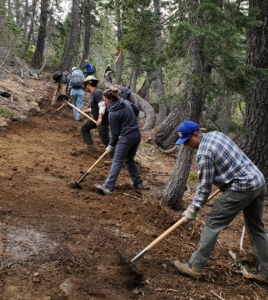A New Trail Emerges in the Wilderness
“A designated single trail will provide a better experience for visitors and protect the surrounding wilderness.”
-Becky Cooper, recreation officer, Shasta-Trinity National Forest
Buying land is just the first step in a long process that not only conserves wilderness, but also allows better protection and restoration of the health of an entire ecosystem that depends on its connection to the land in order to thrive.

Members of the Deadwood Fire Crew working on the Heart Lake Trail, December 2020
When The Wilderness Land Trust purchased a privately owned 637-acre parcel of land that straddles the border of the ruggedly beautiful Castle Crags Wilderness in northern California, it saved the popular Little Castle Lake area from private development and the potential closure of the popular trail that leads to Heart Lake.
But purchasing the land was just the beginning of its conservation journey.
The Castle Crags Wilderness encompasses more than 12,000 acres and is located at the south end of the 11 million acre Klamath Siskiyou wild area that covers northern California and southern Oregon and connects the Pacific Ocean to the Sierra through six wilderness areas. The Castle Crags dramatic granite peaks and densely forested ridges provide critical habitat for Pacific marten, blue ribbon trout, black bear, and the endemic Castle Crags harebell wildflower. Wolves have recently naturally re-populated the area for the first time in decades.
The area also attracts thousands of California locals and others every year. Most of these visitors are drawn to the promise of pristine hiking trails, crisp, clear alpine lakes and rock climbing, all within easy access from well-maintained roads.
Unfortunately, the public has loved the “trail” to Heart Lake a little too much. Over the years, intrepid hikers have created a spider web of unofficial routes across the landscape in their quest to find Heart Lake, to the detriment of the surrounding ecosystem.

To protect the area, in late 2019 U.S. Forest Service staff met with the Mt. Shasta Trail Association and, in coordination with the Trust, devised a plan to create an official trail leading from Castle Lake to Heart Lake. The trail traverses the Trust’s newly purchased property, which will eventually be owned and managed by the U.S. Forest Service as part of the Castle Crags Wilderness.
“Because the original Heart Lake trail was user-created on private land, it didn’t meet Forest Service standards as a sustainable trail,” says Becky Cooper, recreation officer, Shasta-Trinity National Forest. “Building a new trail that meets grade and slope requirements for drainage and erosion control eliminates water quality issues and allows the natural vegetation to come back, including wildflowers in early summer. A designated single trail will provide a better experience for visitors and protect the surrounding wilderness.”
Creating a designated trail while the land is still under the Trust’s ownership and before it is transferred to the Forest Service is a simpler process and saves taxpayer dollars. The new trail was designed carefully to meet Forest Service trail standards and specifications and executed quickly thanks to the Trust’s partnerships with the Forest Service, Mt. Shasta Trail Association and Siskiyou Land Trust.
“On some days, a hundred or more people hike to Heart Lake and without a designated trail, people wander all over the place, creating a maze of user paths in this fragile alpine ecosystem,” says Mike Hupp, board member, Mt. Shasta Trail Association. “The Wilderness Land Trust discussed trail improvements with local conservation groups and the Forest Service during their Community Hike Day in 2019 and we were excited at the prospect of improving this popular area. So when a trail crew became available in November 2020, we were thrilled that the Trust could so quickly enter into an agreement with the Trail Association so we could start work immediately. These improvements will substantially reduce the impact of hikers. This area once supported fields of wildflowers and someday, it will again. Thanks to the acquisition of this special property by the Trust, we have been able to get a head start on restoring this fragile but spectacular area.”

Winter view of Castle Lake from the new trail to Heart Lake
Before deeper snow took hold in mid-December 2020, trail crews had nearly finished three large switchback sections of the trail that are safer, easier to traverse and provide better views than the unofficial trails. In the spring and summer, the crews will continue the long process of restoring the alpine meadows that have been damaged by foot traffic. After the Forest Service takes ownership of the land, it will provide natural barricades across the unofficial trails, re-plant damaged vegetation and help restore the area to its original state.
“This is a huge win for everyone involved,” says Becky. “And once the Trust transfers the land to the Forest Service, we will designate the trail and incorporate it into our National Trail System.”
The Little Castle Lake project builds on The Trust’s 2018 purchase and transfer of more than 1,250 acres southeast of the Little Castle Lake property next to the Castle Crags Wilderness to the U.S. Forest Service for inclusion in the Shasta-Trinity National Forest.


